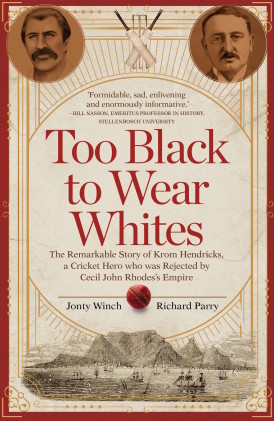Too Black to Wear Whites
Martin Chandler |Published: 2020
Pages: 255
Author: Parry, R and Winch, J
Publisher: Penguin South Africa
Rating: 4.5 stars

Every now and again a book crops up that can only be described as extraordinary, and Too Black to Wear Whites most certainly falls into that category. It is a biography of a cricketer, so nothing inherently unusual in that. But what is remarkable is the man that authors Parry and Winch have chosen to write about, and the lengths that they have had to go to reconstruct his life. That of Krom Hendricks is not a famous name, something not helped by the fact that while he is recorded on Cricketarchive he is misidentified there, and no date of birth or date of death is given there for him.
There is just a single match for Hendricks on cricket’s most extensive database. He, and another man who shared his surname and who Cricketarchive mistakenly refer to as Krom, played in a two day match at Newlands in March 1892 for a team of eighteen Malays against a touring side from England led by the Surrey amateur Walter Read. The match was the last of a three month trip and followed on from an eleven a side fixture against South Africa that was, fifteen years later, accorded Test status.
Read’s men were nothing like representative of the full strength of England but the captain himself, wicketkeeper Harry Wood and Kent bowler Frederick ‘Nutty’ Martin had played in Tests against Australia. In addition Jack Hearne and William Brockwell would do so in the future so this was a decent side. Read also had two leading Australian players in William Murdoch and ‘JJ’ Ferris who both played in the ‘Test’, although neither featured against the Malays, the tourists’ side for that fixture being comprised wholly of their professional complement.
The Englishmen won the contest against the Malays by ten wickets, but the speed of Hendricks’ bowling created a lasting impression on them. Hendricks was then selected in the South African side that was chosen for the return trip to England in 1894 but, through the interference of politicians, did not make the trip. Despite the glowing testimonials of the men who faced him for Read’s side, as well as many others, Hendricks never did play a First Class match, let alone a Test and the name Krom Hendricks slipped into obscurity.
Back in 1994 Richard Parry published an essay on Hendricks in the sadly now defunct Cricket Lore magazine. At the same co-author Jonty Winch was researching Hendricks as well and eventually the pair pooled their resources and considerable research skills to produce Too Black to Wear Whites, a full biography of a fine cricketer whose story is inextricably linked to the more abhorrent political views that afflicted his country throughout his lifetime.
Winch and Parry have secured a foreword to their book from the eminent South African historian Andre Odendaal. In this reviewer’s experience forewords are often not worth reading. This one is the exception that proves that particular rule and is an important starting point.
With a book like this the list of sources and acknowledgments are always illuminating. In the case of Too Black to Wear Whites there is a long list of periodicals, the majority of which are newspapers rather than the traditional cricket press. As for the books many again are non-cricketing texts and the titles of and authors of a considerable number of them make it clear that they are serious academic texts.
Against that background it is hardly surprising that Winch and Parry have been able to reconstruct the political and social history of Hendricks lifetime which, they establish, stretched from 15 October 1957 to 23 September 1940. They have also been able to track down enough detail of Hendricks’ performances on the field to flesh out his cricket career, and to trace the developments in his own life and those of his family. Not too much, inevitably, emerges of Hendricks’ personality and character, but there is more than sufficient there for the reader to gain a decent impression of the sort of man Hendricks was.
The best way to sum up Too Black to Wear Whites is, perhaps unsurprisingly, found in the book itself, as its epilogue begins; Hendricks is a case study in social injustice, of one man caught in a colonial web and his extraordinary story. The racist colonial establishment saw Krom Hendricks’s cricket career as the thin end of the wedge that would open up the exclusive preserves of their domain to the underclasses. The better he was, the more threatening to racially defined privilege he became. He was the first in a long list of sporting exclusions that denied his many successors, including Basil D’Oliveira, the right to represent South Africa.
For anyone who takes an interest in South African cricket or the history of the country Too Black to Wear Whites is highly recommended. The absence of a photographic section is perhaps a slight disappointment, although as far as Hendricks himself is concerned there is little material to work with. That said having commissioned an artist to produce an impression of Hendricks it is a little surprising that the use of it is limited to what amounts to a thumbnail on the front cover. That small point apart the book is very nicely designed and has an excellent index. Most importantly of all course is the quality of the writing, and I am delighted to report that the authors did not lose sight of the fact that their readers will not all be academics.






Leave a comment